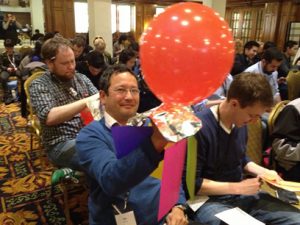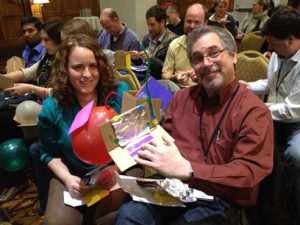Learn how to utilize Design Thinking in your role as a leader. This essay, Leader as Designer, by Mariposa Leadership CEO Sue Bethanis, opens up Design Thinking to different applications and audiences that goes beyond product development. She offers a clear 4 step process to easily move from idea-to-innovation. The results: successful services, new experiences, and novel solutions to old problems.
Download PDF
“We are on the cusp of a design revolution in business. As a result, today’s business people don’t need to understand designers better, they need to become designers.”
—Roger Martin, Dean of University of Toronto’s Rotman School of Management
Roger Martin equates the role of “designer” with “leader.” I do, too. He and I are not talking about graphic design or interior design or designing the next Eames-like masterpiece. Instead, we are talking about Design Thinking—a movement, a model, and a philosophy that has caught on in business schools and business settings. Design Thinking taps into imagination and practicality, which taken together form the backbone of creative problem-solving and
innovation.
There are a myriad of definitions of Design Thinking, many of which you can read about in the Executive Guide to Design Thinking. I see it as my role in coaching and writing to curate and translate various available theories and approaches, and my hope is that you use Design Thinking to help your teams think differently, solve problems, and come up with the next new things.
In describing Design Thinking, I have settled on the Breakthrough! model (detailed below) which emphasizes idea-to innovation. Since I was a college student, I have believed an idea is only as good as its usefulness and adding Design Thinking to my repertoire three years ago only deepened my belief in this mantra. Things, services, and experiences can be beautiful and interesting, and practicality is still the key to good design!
In my coaching, I observe leaders who are “popcorners”: They’re considered visionaries who come up with an idea a minute—often in isolation—many of which don’t go anywhere. Even more often, I see leaders who “put all their eggs in one basket” and settle on one idea too quickly—again in isolation from their internal or external customers—and implement it without much testing or gathering enough feedback. For “popcorners” and “eggs-in-one-basket”-type leaders, their ideas often don’t materialize into innovations. A Design Thinking approach offers a practical way to get from idea-to-innovation, and I hope the Breakthrough! model of Design Thinking will serve you well.

When you apply the Design Thinking principles of the Breakthrough! model to leadership, it looks like the following: Ask lots of well thought out questions, brainstorm frenetically, prototype imperfect things and experiences, test out multiple prototypes, fail fast, and start all over again. This is what being a designer is, and this is what leaders who are design thinkers do to help solve some of the seemingly intractable issues faced in this rapidly changing business landscape.
Whether you are trying to make a new product, establish a new service, design a workshop, figure out a new operation or process, delineate a new sales strategy, or productize a service, the Breakthrough! model can be applied. Each facet of the model can be used as a stand-alone tool; however, the overall process provides the necessary arc to set and solve the most wicked problems in a team or organizational setting.
Empathy – Put yourself in your customers’ shoes through interviewing and observation.
We create products, services, and experiences in isolation too much of the time. We need to have intimate knowledge of the users/customers by seeing people in action. We need to ask lots of well-thought-out, imaginative questions; videotape people in action; and sit next to an internal or external customer to experience what they are experiencing and feeling. This gives us context, and gives us a better chance to design something that will work best for the customer, not just for us. Constant customer feedback is vital when we are creating a new product or service. The same is true when we are solving even a simple problem.
A leader who is a design thinker will automatically look at a problem from multiple viewpoints. Good designers and leaders are “T-shaped”: They have both horizontal perspectives and vertical skills. The vertical axis is typically the specialty in which you have been trained (in college and on-the-job) like accounting, psychology, industrial engineering, mechanical engineering, graphic design, or marketing. The horizontal axis portrays your ability to both empathize with and master disciplines other than your primary one. Thus, an optimal T-shaper is one who has a strong discipline and also takes the time to empathize with and apply other disciplines. For example, a General Manager (GM) of a game studio may have a vertical background as a product manager and be trained in and terrific at getting product features out the door; by comparison, a highly successful GM of a game studio also understands and applies knowledge in business analytics, user/customer experience, and organizational development. In other words, he or she is part MBAer, part designer, part anthropologist, and part coach.
Two good tools that get at empathy are journey mapping and contextual interviewing.
- Journey mapping is plotting out each aspect of a customer’s experience. It is a good primer before you go into contextual interviewing. A couple of months ago, I did a customer journey map with a 7-person data storage marketing team made up of directors and managers. We actually did it over the phone, which I would not normally recommend. Even with that, I was amazed with the insights they were able to gain. This marketing team went through every touchpoint their external customer had in making decisions about buying their company’s most popular storage product. By going into minute detail and putting themselves in the customers’ shoes (their thinking and feelings), they were able to see some areas of opportunity that they had previously missed. When the team’s assumptions became clearer, they wanted to test them out. This required them to influence their sales counterparts to let them interview the customers and offer up a different set of questions than their sales partners had asked in the past.
- Contextual interviewing is conducting conversations to understand the customer’s experience in their world. Early last year I helped a big data startup come up with pinpoint questions designed to get as close to potential users’ context and experience as possible. I encouraged the two founders to do as many interviews fact-to-face at the potential customers’ job sites or workspaces instead of on the phone or at their local Starbucks. The founders got such rich data from their “contextual interviewing” that they changed the direction of their startup because they saw a stronger need for a different kind of product.
The kind of data that you can get from journey mapping and contextual interviewing gives you the information you need to “set” the problem you will try to solve with brainstorming and prototyping. And having different perspectives in the room also helps “set” the problem.
Brainstorm – Do frenetic brainstorming that produces 100-200 new ideas; cull those ideas and determine which ones could be breakthroughs.
Remember the last time your team did a “brainstorming session”: You sat around a flip chart, blurted out a few things, and tried really hard not to judge someone else’s ideas as someone tried to write on the flip chart the ideas that he/she heard. Throw that method out and try this one instead. I learned a variation of this at the Stanford Design School:
- As the leader, come to your team with a specific question you want answered. This can be a question distilled from journey mapping or contextual interviewing. Or a question related to an internal team matter.
- Encourage your team to be fearless, have fun, think differently and imaginatively.
- Create 3-4 groups and give each team member a pack of sticky notes; ask each team member to write one idea on one sticky note, and say the idea out loud as he/she puts each sticky up on the wall.
- After 10 minutes ask each team to count their stickies; then ask each group to double the amount of their stickies in the next 10 minutes. Remind them to merely put their ideas up on the wall and not comment on others’ ideas.
- Let another 10 minutes pass…then see how many ideas were generated.
- Take another 10-15 minutes for each group to look at the ideas as a whole.
If you employ this type of brainstorming, you will generate more and more varied ideas. It also nicely balances the individual and the group. People need to have time and space to do imaginative thinking on their own while also getting support from the group. Brainstorming the ideas is the easy part; culling and curating the ideas is harder. Use all or a few of the following questions to help you sort the data:
- What are the patterns and/or themes you see in the data?
- What are the outlying ideas?
- What idea is your favorite?
- Based on the problem, what idea(s) carry the most energy for a breakthrough?
- Does it make sense for each person to develop one prototype? Or should small groups of 2 or 3 form to build a prototype together (or both)?
I have worked with many groups using this brainstorming protocol, and the key to success is casting a wide net. That little gem in the rough appears when you least expect it.
Prototype – Build prototypes rapidly, get feedback from users, refine product and relationships.
Prototyping is the “design doing” of Design Thinking, and it is the bridge between ideas and innovation. Once you have built an initial prototype, this is your vehicle to collect feedback from users and potential customers. This back and forth process is typically called iteration.
Prototyping takes on many hues depending on whether you are engaging in product or service design or creating an experience.
- If your goal is to design a new product, here are some points to keep in mind:
- “Rapid prototyping” is a term IDEO and Stanford d.school adhere to; they mean build your model fast and cheap, and sacrifice beauty for speed so you can get feedback sooner rather than later.
- “Fail fast” is another important guideline that goes against the grain of traditional product development. The quicker you know your prototype doesn’t work, the better, so you can try something else.
- Refine your product by getting customer feedback through interviews and observation. Watch your potential customers use your product in their environment and videotape their experiences. It is great at this stage if you can have an attitude of detachment so you’re more open to feedback and change.
- Hopefully, you started to build a relationship with current users and potential customers in the empathy stage, and now in the prototype stage, here’s where you want not only to refine your product, you also want to refine your relationships. Your goal is to have a long-standing sustainable relationship so you can continue to go back to them for feedback, testimonials, and eventually, referrals.
- If your goal is to design a new service, all of the above points apply as well as the following:
- Oftentimes when we design something non-tangible (think Virgin America’s kick-ass flying experience or an experiential workshop on influencing skills or ease of use at the ATM), we describe the experience in 2-D. We put it on PowerPoint and/or we tell a story with a lot of words. Tim Brown of IDEO often refers to prototyping as “building to think.” So even if you are designing a service or experience that seems non-tangible, make it tangible. Draw a storyboard of the step-by-step process of what the user will experience. Better yet, use raw materials with your hands to make a 3-D version of the service or experience.
- If your goal is to solve a team problem and design a new experience, I want to strongly encourage you to make 3-D models of the potential solutions that you and your team have brainstormed.
- Here are 3 recent “problems” I have facilitated with teams:
- Networking Marketing VP/Directors: What is our 3-year vision?
- City Government Managers: How do we best engage our employees to prevent burnout?
- Social Media HR VP/Directors: How do we best productize our services?
- There is no question that in coming up with the solutions to these problems, the teams could have used PowerPoint and even added a few nice photos or graphics to their presentations to capture the emotions of the users and/or employees. However, when you add the element of 3-D, it certainly livens up the solutions, and it allows you to use your right brain while you’re building. The 3-D versions act as lasting symbols that you can proudly show to your colleagues, use to decorate your desk, and of course, test with your employees. In the Breakthrough! workshops, I bring in a big backpack filled with raw materials—construction paper, PVC tubing, hot glue guns, straws, tons of markers, pipe cleaners, foam board, rubber bands, LED lights—so participants can turn concepts into breakthroughs. Remember, this process is less about drawing (2-D) and more about making (3-D), like the two examples here.
Last, whether you’re building prototypes for products, services, or experiences, it’s important to put attention into the space you’re using. Be sure you allow ample room for people to spread out, be
messy, and be in their own worlds. Unless you are trained as an artist or product designer, the process of “making” things may cause some anxiety and resistance in people. Ensure that the environment is comfortable and fun and has some natural light.
Implement – Determine what works through testing and influence.
Implementing starts as a very soft launch. In this stage, you will test your product, service, or solution for an extended period of time, continue to refine it, and determine who you have to influence to get your product, service, or solution approved or blessed. Here are some essential elements of this stage:
- You will want to test a more refined version of your prototype, and if you are a product developer, perhaps you have now transferred your prototype from handmade to computer-made. Inexpensive technology now available allows you to print prototypes on a desktop 3-D printer. It’s pretty amazing, actually, and if you haven’t seen or used this technology, I highly recommend it. I believe these devices alone will shift the way we design products.
- You will determine what users will test your refined product, service, or solution. Perhaps it is the same internal or external customer you partnered with on the prototype, or perhaps you have referrals from these customers. With these users, you can pilot a workshop or ask a customer to use your refined product for a couple of weeks; all the while you will be collecting more data.
- Depending on how refined your product, service, or solution is, at this time, you will need to start planning one or all the following:
- develop your go-to-market strategy
- choose your internal partners to form a team
- gather success data in order to make your business plan
- determine who you have to influence to get budget to manufacture your product, or roll out your service or solution.
- Whether you are attempting to implement a product, service, or solution, please keep in mind: No matter how neat your prototype is, implementing requires more than just a happy user or customer; influencing the internal decision-makers is just as essential in order for your idea to become a true innovation. Your idea cannot stand alone on its beauty, coolness, performance, or even its usefulness. So much of what determines whether your idea turns into an innovation depends on your ability to influence your boss, your colleagues, the finance department, etc. More than any other single dilemma I hear from my clients is: How do I convince the so-and-so department to adopt my (you name it)? Influencing skills have always been an essential aspect of leadership (see Leadership Chronicles of a Corporate Sage), and influencing skills are central to Leader as Designer. There are many resources on influencing skills; please consider two of my favorite authors, Dan Pink and Robert Cialdini.
Conclusion
My goal in this essay is to open up Design Thinking to different applications and audiences, and to offer up a clear process to go from idea-to-innovation. The Breakthrough! model is not just a way to design cool products (it is that!); it is also an engagement method that leaders can use to solve problems. If your tendency is to be impetuous, then be sure to interview your users/customers/employees before you try to sell them your product. If your tendency is to sink into scads of data so that you can perfect the ultimate product or experience, then stop, make a prototype of your concept and get it out to users ASAP to see what people think and feel. If you’re already using the Breakthrough! model or some semblance of it with success, fantastic! Then get out there and coach someone else to be a Leader as Designer!
Finally, I welcome your comments and questions! This essay is merely a prototype; there will surely be more iterations!
Download PDF
MORE






